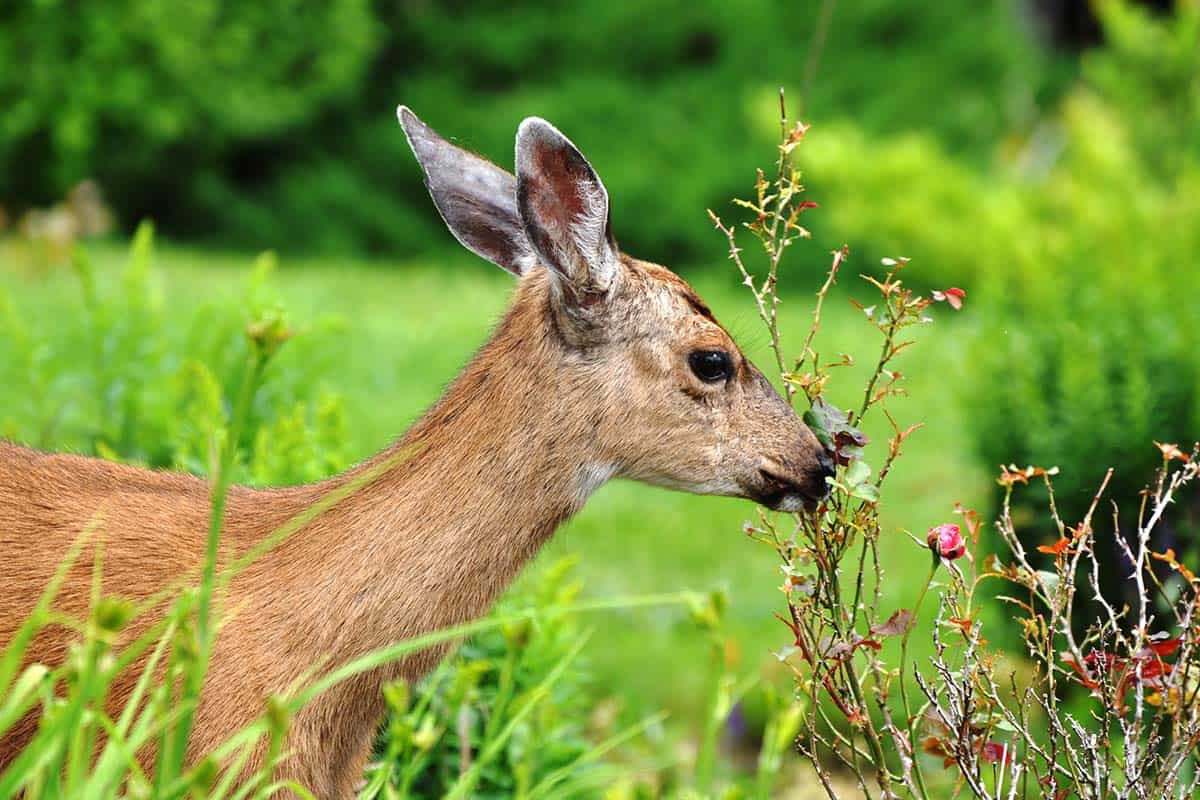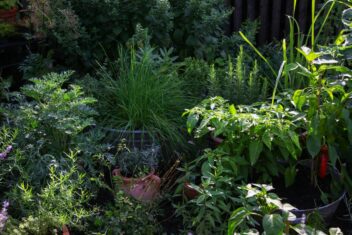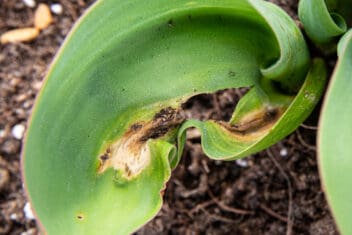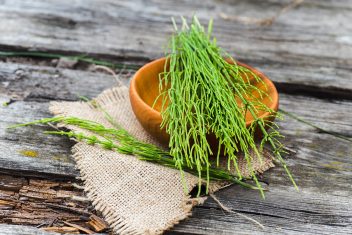Deer are beautiful creatures, but they can also be quite a nuisance if they begin to eat your garden, berry patch, orchard, or your favorite flowers.
So what do you do about them?
Well, there are quite a few humane solutions that can help you get rid of deer from your garden. And that is what we have for you today.
Ways to Keep Deer Out of the Garden
1. Don’t Plant Things That Tickle Their Taste Buds
There are certain things that you can plant in your yard that are going to scream ‘endless buffet’ to a deer. By not planting too many of those things, it will help make your yard a little less attractive to them.
This might sound like bad news if you like some of the plants mentioned below, but that’s the compromise you should be willing to make.
Here’s the list of plants deer love, and therefore you shouldn’t plant:
- Hostas
- Daylilies
- Roses
- Azaleas
- Pansies
- Tulips
- Impatients
- Hydrangea
- Sunflowers
- Yew
- Wintercreeper
- Fruit trees
- Lettuce
- Beans or peas
- Berry bushes
These are plants that deer not only eat but will attract them to your property because of the colors and smell.
The last four on the list might be a huge bummer if you’re a food gardener because they are among the most popular plants to grow. However, worry not, there are still other ways to deter deer.
2. If You Have To, Plant Them Close to Your Home
If you love your fruit trees and refuse to let deer dictate what to grow in your own yard, then good for you. (Just don’t be surprised when they still hang around.)
There is one easy thing you can do to protect your plants: Plant them close to your home.
Deer are amongst the lowest-ranked animals in the food chain and they have a lot of predators. So their natural reaction to seeing other creatures is to run and hide. It’s in their built-in defense mechanism.
If you plant those plants close to your home, it’s more unlikely that they’ll take the risk and come nearby.
Plus, it’s easier for you to keep your eyes on nearby plants.
3. Grow Strong-Scented Perennials
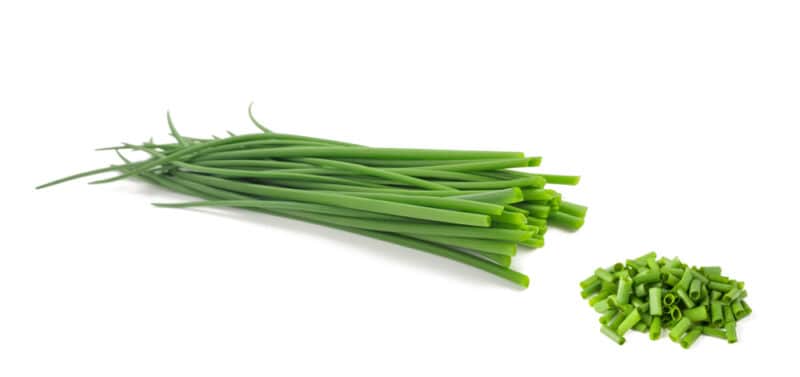
Deer have a very sensitive nose. It’s another one of their defense mechanisms against predators. In comparison, humans have 5 million scent receptors, dogs have 220 million, and deer have 297 million.
If you want to keep them away, then plant plants that have a strong smell. Even better if they can grow year-round, hence perennials.
Asparagus, horseradish, garlic, lavender, and chives are great perennial plants to deter deer. You can also plant non-perennials like thyme, sage, mint, ginger, rosemary, and parsley.
Keep in mind that there are no true deer-resistant plants other than the poisonous ones. If deer have no choice, they might eat them too.
4. Plant ‘Uncomfortable’ Plants around the Plants You Want to Protect

There are some plants that are not ideal for deer to dig through to get to the plants that they desire. Mainly plants that are prickly or feel different on your skin.
Some examples are fuzzy lamb’s ear, cleome, and barberries.
We humans don’t feel anything weird with the way these plants feel against our hand, but deer won’t enjoy it against their super-sensitive nose as they’re trying to rustle through them to get to the plant that they desire.
5. Substitute Plants with a Similar Plant That Deer Don’t Love

You’ve seen the list of plants that deer love. So instead of planting them, see if there is a similar plant that can take its place that is less appetizing to deer.
A very common substitute is trading tulips with daffodils. Okay, they don’t look similar, but daffodils are beautiful flowers that will still add the vibrant colors that most people plant tulips for. Not to mention, both plants come back year after year.
Another good substitute is planting rose varieties with more thorns. The less thorny options may make gardening easier, but it also makes it easier for deer to eat them too. It is a bit of a gray area if we’re talking about humane methods, though, because thorny roses might hurt them.
Try to keep those substitutions in mind as you decide on which plants to use at your home this year.
6. Place a Privacy Fence or Hedge about Your Garden
Placing a tall fence around your garden to help keep deer out is an effective method. However, this option can be costly unless you choose to make a fence from pallet woods.
Using a deer-resistant hedge of shrubs around your property is also a great option. If you hide the enticing plants from their sight, getting into your garden becomes less enticing.
Some good options for hedge shrubs are boxwood shrubs, cherry-laurels, green giant arborvitae, and virescens western red cedars.
Keep in mind that just like the case with deer-resistant plants, there are no true deer-resistant shrubs. Deer might still eat it if they’re desperate enough.
Also, have a look at our article on deer proofing your garden for more options on fencing, etc.
7. Plant the Deer’s Favorite Foods
Okay, this may sound counter-intuitive. Just listen for a second.
If you have a large property, it’s really hard to keep deer out of it, and installing a deer-resistant fence becomes a very expensive option.
The solution? Plant their favorite plants at the edge of your yard.
This will keep them from wanting to enter your yard. And if their belly is full, they will go away without ever disturbing you and your garden. Why risk entering an unknown place when you can get easy food, right?
One big downside to this method is that if your area has a lot of deer already, you’ll only make the problem worse for people around you.
8. Give Them a Little Shock
There’s something called a static shock repellent.
The idea is to lure deer in with scent. Then give them a little shock. After they get shocked a few times, hopefully, it will send the message that they aren’t welcome there, and they’ll leave your property alone.
The product claims to be harmless to deer, but we’ll leave the decision to you about it being humane.
9. Take the Bird Feeder Down
I know a lot of people love having birds in their yards. They put out lots of different bird feeders to attract them and then they get to watch them all day long.
I get why it’s a fun activity. The only problem is that bird feeders are easy food for deer. So you’re not only bringing in birds, but you are also enticing the deer to come too.
So if you want to keep the deer out of your garden and flowers, then take down the bird feeders.
10. Make a Little Noise

Deer are very skittish creatures. They don’t like noises, especially loud noises that are unfamiliar with. So if you are having an issue with deer, then you can try making some noise.
There are lots of different options to make noise to keep deer at bay. You can make a wind chime out of tin cans or even buy one.
You can also use fireworks or even the static from a radio. Just use a dial radio and place it in between stations. That loud static noise should be enough to scare off any deer in the area.
This approach may or may not work depending on the deer. Some deer don’t mind the noise if they’re desperate to get some food, and some eventually get used to the fake danger.
11. Shed Some Light on the Subject
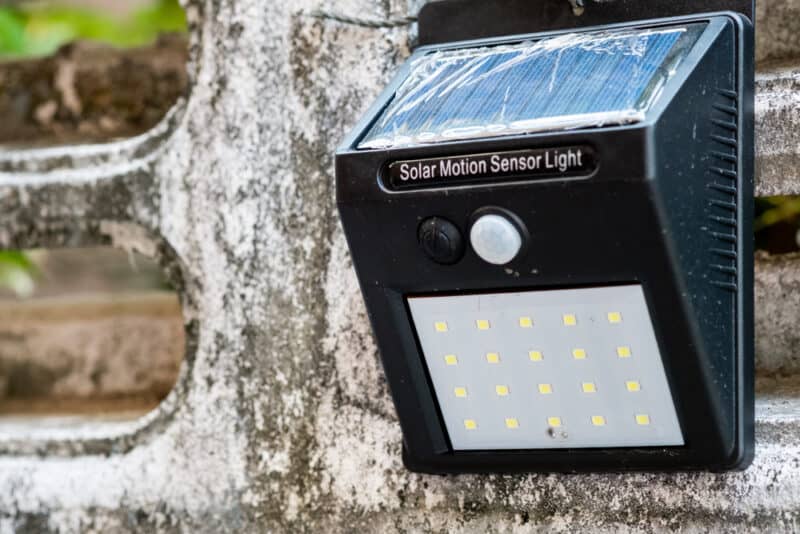
I have a funny memory with motion lights.
My grandmother would get so mad when a stray cat would walk across her car. So when she see paw prints on her windshield, it would drive her insane.
Finally, she got the idea to use a motion light and every time one of those stray cats would walk across her car under the carport, the light would come on. It stopped her stray cat problem.
It can be the same case for you with your deer problem. Motion sensor lights scare them so it should keep them away.
12. Turn the Sprinklers On
This would be enough to scare away a human, let alone a deer.
Just as there are motion-activated lights, there are also motion-activated sprinklers, which will make the getting-rid-of-deer job easy for you.
13. Let the Dog Out
If you have a deer problem and a dog, then simply open your door and let your dog out.
This might sound almost too easy, but deer are very afraid of predators. So if they hear other animals they are most likely going to avoid the area. It’s a method proven by humans throughout the centuries.
14. Put Your Fishing Line to Use
A fishing line is great for a lot of things other than just fishing. It can even be used to protect your plants against deer.
To do this, you’ll need to stake fence posts at around 15-feet intervals around your garden, or one at each corner for smaller gardens. Then at about 2-feet off the ground, tie the fishing line at the first post. Go to the next post, wrap your line 3-4 times, and go to the next post until you’re back to the first one.
Move another 2-feet from the first line and repeat the process until the last line is about 8-10-feet high.
The reason this method is effective is that deer can’t easily see something semitransparent so when they approach your garden and feel there’s an object, they won’t be able to judge how high the obstacle is for them to jump over, so they won’t.
The above video will guide you through the process of putting a fishing line.
15. Try Some of These Homemade Repellents
There are so many homemade repellent options you can try, but the key to using any homemade option (or any option in this article, for that matter) is to keep switching them up. When a deer becomes familiar with your tricks then they’ll no longer work.
The first homemade repellent trick is hanging fabric softener strips or bar soap from your trees and plants. It is an unfamiliar smell and will trip up their scent and deter them from your property.
Second, try hot pepper sprays. That will mess with their sense of smell and their taste buds. Since it is unfamiliar, it will scare them away.
Other options like garlic, blood meal, or ammonia-soaked rags will impact their senses as well.
Keep rotating your methods and come up with a new one, you’ll be surprised how quickly deer get used to a certain smell.
All homemade repellents are based on smell to take advantage of their sensitive nose. So you can try anything that is strong-smelled, just make sure it’s not harmful to humans and other animals.
16. Use Proven Store-Bought Repellents
As I mentioned, you should rotate your repellent options or methods frequently so deer don’t become used to it. This is still true for store-bought repellents.
If you’re not sure which product to buy, try the ones from our list of deer-repellent that we’ve reviewed.
17. Wrap Your Seedlings
When you first transplant your seedlings in your yard, it is very common that animals will make a snack out of them. Deer are one of them.
To avoid this, you can place netting over fruit trees, bulbs, and new bushes.
You can also add garden nets and tree protectors to go over other items you may have planted in your garden or orchard.
Wrapping your seedlings should hopefully help them so they won’t become a deer’s lunch.
18. Make a Scarecrow
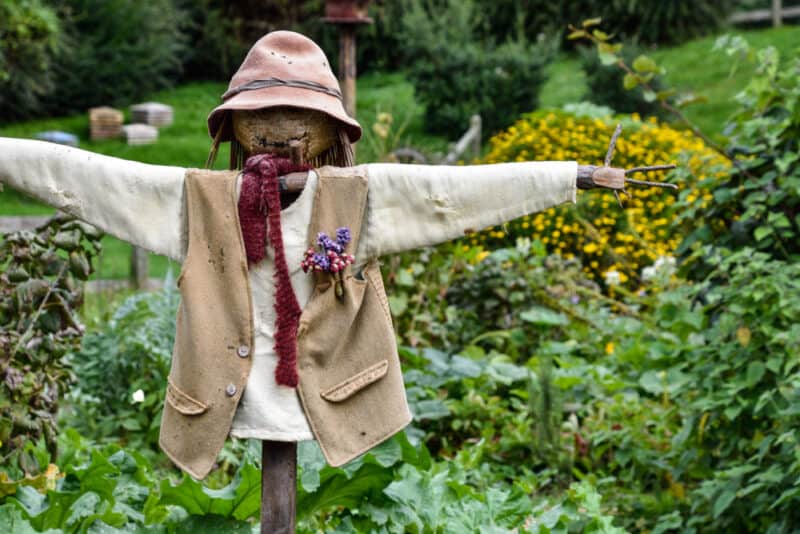
Scarecrows have been working for many, many years to keep pests out of the garden and to protect your harvest.
They are very easy to make. I must say, the only downside to a scarecrow is that they might scare people.
We used one during our first year of gardening, and I haven’t used one since. Every time I walked out in the garden it scared me half to death because I always thought there was someone standing in the middle of the garden.
After I jumped all season long, I decided never again. We switched to pie plates attached to sticks with string after that.
19. Cleanliness Helps
Another effective way to keep deer out of the garden is cleanliness. By keeping your garden area clean, you are making it less homey for deer.
See, the deer will bed down in tall grass. So if you leave lots of tall grass around they’ll think it is there as a great bed for them.
Also, pick your fruits and vegetables immediately when they are ripe. If you leave fresh veggies just laying around, the deer will think it is a free meal for them.
Finally, discard your crops after harvest. Deer like the plants themselves too. So if you get rid of them as soon as you’re done with them then it should keep them out of your garden.
20. Create Uneven Ground
By creating unleveled ground (or at least make your ground appear unleveled) it’ll make it harder for deer to fool around on.
You can stack up pallets at the tree line to make it look like deer have to climb things to get in or get out of the property. Because deer are not avid climbers, like a goat is, they prefer to not have to deal with those challenges and will move on to look for food elsewhere.
Well, there you have it. You have 20 ways you can try to keep deer out of the garden. Maybe one or more of these methods will be satisfactory to you. However, remember to switch them up as often as you can so that deer don’t get used to them.
